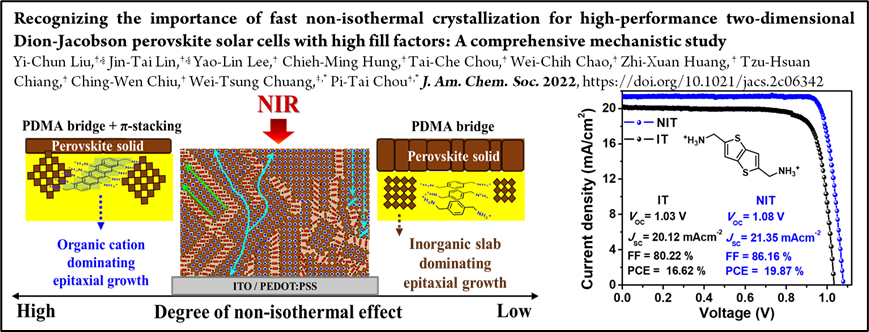- The full article entitled “Recognizing the Importance of Fast Nonisothermal Crystallization for High-Performance Two-Dimensional Dion-Jacobson Perovskite Solar Cells with High Fill Factors: A Comprehensive Mechanistic Study” can be found at the JACS website at https://pubs.acs.org/doi/10.1021/jacs.2c06342
- Authors: Yi-Chun Liu, Jin-Tai Lin, Yao-Lin Lee, Chieh-Ming Hung, Tai-Che Chou, Wei-Chih Chao, Zhi-Xuan Huang, Tzu-Hsuan Chiang, Ching-Wen Chiu, Wei-Tsung Chuang,* and Pi-Tai Chou*
The pollution caused by petrochemical energy and the intensified global warming have prompted people to seek alternative sustainable energy sources. In particular, solar energy has received the greatest attention: In principle, only 1% of land area is needed to supply the world's energy consumption if the power conversion efficiency of solar cell can surpass 10%. Among the new generation of photovoltaic materials, hybrid halide perovskites are generally considered to be the most promising candidate. Especially, solar cells based on the two-dimensional (2D) perovskites have attracted great attention in recent years due to their improved long-term operation stability comparing to that of 3D-perovskite solar cells. However, the conventional fabrication methods are prone to induce chaotic crystallization in thin films of 2D-perovskites, resulting in poor crystal arrangement and substantial defects, which eventually lead to poor fill factors and power conversion efficiencies. In this regard, a research team consisting of Professors Pi-Tai Chou and Ching-Wen Chiu from the Department of Chemistry, National Taiwan University and Dr. Wei-Tsung Chuang, a research staff at the National Synchrotron Radiation Research Center, develop a strategy for improving the structural ordering in 2D-perovskites via π-π stacking between organic cation ligands. This, together with the introduction of infrared heating technology, improves the uniformity and crystallinity of 2D-perovskites. The solar cells fabricated with this technology can achieve an 86% fill factor as well as a nearly 20% power conversion efficiency. This represents a great success in the development of 2D-perovskite solar cells.
